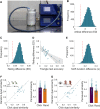There is chemistry in social chemistry
- PMID: 35749498
- PMCID: PMC9232116
- DOI: 10.1126/sciadv.abn0154
There is chemistry in social chemistry
Abstract
Nonhuman terrestrial mammals sniff themselves and each other to decide who is friend or foe. Humans also sniff themselves and each other, but the function of this is unknown. Because humans seek friends who are similar to themselves, we hypothesized that humans may smell themselves and others to subconsciously estimate body odor similarity, which, in turn, may promote friendship. To test this, we recruited nonromantic same-sex friend dyads and harvested their body odor. We found that objective ratings obtained with an electronic nose, and subjective ratings obtained from independent human smellers converged to suggest that friends smell more similar to each other than random dyads. Last, we recruited complete strangers, smelled them with an electronic nose, and engaged them in nonverbal same-sex dyadic interactions. We observed that dyads who smelled more similar had more positive dyadic interactions. In other words, we could predict social bonding with an electronic nose. We conclude that there is indeed chemistry in social chemistry.
Figures




Similar articles
-
Smelling is Telling: Human Olfactory Cues Influence Social Judgments in Semi-Realistic Interactions.Chem Senses. 2017 Jun 1;42(5):405-418. doi: 10.1093/chemse/bjx012. Chem Senses. 2017. PMID: 28369183
-
A dyadic perspective on aggressive behavior between friends.Aggress Behav. 2021 Mar;47(2):194-204. doi: 10.1002/ab.21938. Epub 2020 Nov 26. Aggress Behav. 2021. PMID: 33244790
-
Dyadic analysis of adolescent friendships behaviours during pain: Comparison of those with chronic pain versus those without chronic pain.Eur J Pain. 2022 Feb;26(2):428-444. doi: 10.1002/ejp.1869. Epub 2021 Oct 26. Eur J Pain. 2022. PMID: 34614279
-
Olfaction and identification of unrelated individuals: examination of the mysteries of human odor recognition.J Chem Ecol. 2006 Aug;32(8):1635-45. doi: 10.1007/s10886-006-9098-8. Epub 2006 Aug 2. J Chem Ecol. 2006. PMID: 16900423
-
The anatomical logic of smell.Trends Neurosci. 2005 Nov;28(11):620-7. doi: 10.1016/j.tins.2005.09.005. Epub 2005 Sep 21. Trends Neurosci. 2005. PMID: 16182387 Review.
Cited by
-
The absence of one's intimate partner promotes dyadic competition through enhanced interbrain synchronization between opponents.Front Psychol. 2024 Jan 24;15:1298175. doi: 10.3389/fpsyg.2024.1298175. eCollection 2024. Front Psychol. 2024. PMID: 38328380 Free PMC article.
-
Social odor choice buffers drug craving.Neuropsychopharmacology. 2024 Mar;49(4):731-739. doi: 10.1038/s41386-023-01778-y. Epub 2023 Dec 21. Neuropsychopharmacology. 2024. PMID: 38129664 Free PMC article.
-
Why dogs prefer zoomies to zoom and what it tells us about the importance of in-person meetings for learning and memory.Cogn Process. 2025 Feb;26(1):231-234. doi: 10.1007/s10339-024-01235-8. Epub 2024 Oct 14. Cogn Process. 2025. PMID: 39400658 Free PMC article.
-
Nature and human well-being: The olfactory pathway.Sci Adv. 2024 May 17;10(20):eadn3028. doi: 10.1126/sciadv.adn3028. Epub 2024 May 15. Sci Adv. 2024. PMID: 38748806 Free PMC article. Review.
-
Body odor samples from infants and post-pubertal children differ in their volatile profiles.Commun Chem. 2024 Mar 21;7(1):53. doi: 10.1038/s42004-024-01131-4. Commun Chem. 2024. PMID: 38514840 Free PMC article.
References
-
- Winstead B. A., Derlega V. J., Benefits of same-sex friendships in a stressful situation. J. Soc. Clin. Psychol. 3, 378–384 (1985).
-
- Demir M., Davidson I., Toward a better understanding of the relationship between friendship and happiness: Perceived responses to capitalization attempts, feelings of mattering, and satisfaction of basic psychological needs in same-sex best friendships as predictors of happiness. J. Happiness Stud. 14, 525–550 (2013).
-
- S. Degges-White, C. Borzumato-Gainey, Friends Forever: How Girls and Women Forge Lasting Relationships (Rowman & Littlefield, 2011), p. 296.
-
- Byrne D., Gouaux C., Griffitt W., Lamberth J., Murakawa N., Prasad M., Prasad A., Ramirez M., The ubiquitous relationship: Attitude similarity and attraction: A cross-cultural study. Hum. Relat. 24, 201–207 (1971).
-
- Granovetter M. S., The strength of weak ties. Am. J. Sociol. 78, 1360–1380 (1973).
LinkOut - more resources
Full Text Sources

